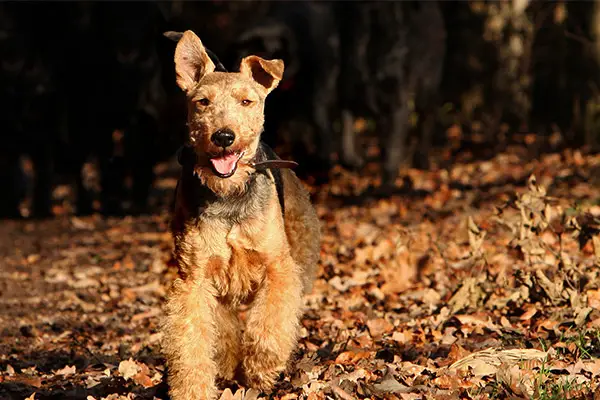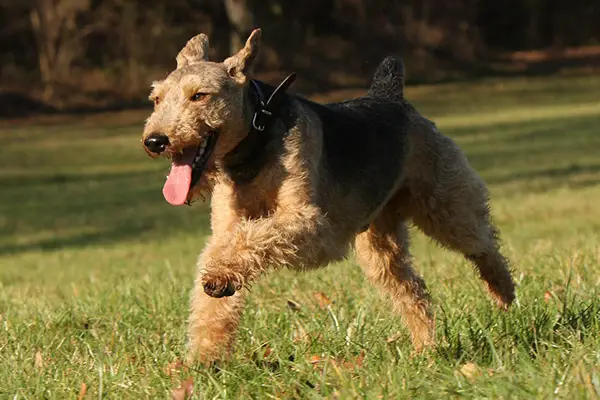
Welsh Terrier dogs look like Airedales but smaller. They have compact bodies covered with a tight-fitting coat that comes in black and tan colors. Their heads are rectangular and feature a beard and folded ears.
Welsh Terriers might be small in size, but they have big personalities. They are not dogs for those looking for a quiet and well-mannered pet indoors. These dogs can be a challenge to train, and their boundless energies can be overwhelming if you’re inexperienced.
For the right person or family, however, Welsh Terriers can become devoted family companions. They are the best fit for active families. These dogs don’t need lots of attention, but they do love cuddles, hugs, and lots of affection.
Welsh Terrier Breed Statistics
| Dog Breed Group | Terrier |
| Breed Size | Small |
| Height | 15 inches (male); proportionally smaller (female) |
| Weight | 20 pounds (male); proportionally smaller (female) |
| Lifespan | 12-15 years |
Welsh Terrier Breed Ratings
| Energy level | |
| Exercise needs | |
| Requires attention | |
| Playfulness | |
| Trainability | |
| Shedding | |
| Grooming | |
| Friendly with family | |
| Friendly with kids | |
| Friendly with strangers | |
| Friendly with other dogs | |
| Prey Drive |
Welsh Terrier History
Welsh Terriers are believed to have been developed sometime in the 1700s. However, there’s no way of telling about their exact origin. There were also many old paintings and prints of black and tan wirehaired terriers that resemble the dog breed.
These dogs were thought to have been developed to hunt foxes, otters, and badgers. They are frequently found in the mountainous region of Wales, hence their name. And although they were more associated with the place, they can also be found all over England in the 19th century.
They were originally known as Black-and-Tan Wire Haired Terriers or the Old English Terrier. That was until 1885 when the Kennel Club of England named the breed Welsh Terrier.
In the year 1888, Welsh Terriers were first imported to the United States. The dogs were immediately brought to the Westminster Dog Show. In that very same year, the American Kennel Club recognized the breed, and two years later, the Welsh Terrier Club of America was formed.
Since 1901, Welsh Terriers established their name in the Western Lands, and their popularity grew. Now, the breed ranks 107th as the most popular dog breed in the US.
Welsh Terrier Temperament
Welsh Terriers are generally friendly, spirited, and intelligent dogs. They are not as excited or playful as some terrier breeds, but they are still highly energetic dogs.
They are the best fit for active owners. Take him with you when you travel, and create outdoor activities that he can join in. These dogs need exercise, lots of it, and the more you can give this to them, the easier they are to handle indoors.
Welsh Terriers are known to be more sociable than most terrier breeds. They get along well with other pets but must be supervised when around little children. They are friendly with strangers too, but you can still expect them to bark to alert you when he sees something suspicious.
As stubborn and persistent dogs, Welshies need consistent and firm leadership. Positive reinforcements are highly encouraged for you to do, as this will help with his obedience training. If you’re having a hard time, you can take him to a puppy school.
Socialization should be given at an early age. This will help him get accustomed to new people, animals, sights, or sounds. It will also help him be more well-rounded dogs.
Welsh Terrier Care Requirements
- Nutrition: Welsh Terriers require a high-quality and well-balanced meal to keep him happy and healthy. One meal should consist of all the essential nutrients like proteins, fats, carbohydrates, and vitamins. Make sure only to buy high-quality ingredients if you’re going to serve a home-cooked meal. If you plan to give him dog food, buy the premium-quality ones. Avoid those with fillers, by-products, and additives in the ingredients as they have low nutritional value and may cause indigestion. Watch the number of calories you feed your dog in a day. You can ask your vet for a guide on how much to feed him. This would depend on your dog’s age and daily activities.
- Grooming: Welsh Terriers have wired coats that shed occasionally. However, brushing is still needed a few times a week to prevent tangles and mats from forming. This will also help remove any dirt in the hair and strengthen your bond in the process. The hair of Welsh Terriers are not trimmed but are plucked instead. Make sure to take your dog to an expert groomer every 2-4 months, so he stays looking clean. Baths can also be given at this frequency, but make sure to clean the ears regularly. Trim the nails regularly, too. Long nails will cause your dog pain and discomfort.
- Exercise: Welsh Terriers is a highly energetic dog breed. They love exercises, and they love this more when they do it with their owners. You can create activities that you can do with your dog, such as chasing balls, discs, or having him run around in a secured fence. Daily long walks should also suffice. Keeping your Welshie exercised will not only make him healthy and happy, but it will also keep him well-behaved. As they mature, keep exercise to a minimum and make sure not to over exhaust them.
- Health: Welsh Terriers are generally healthy dog breeds. They have a long lifespan, but as dog owners, it’s essential to know what diseases may affect our dogs. This information will also help us prepare and prevent them from getting these health issues. The most common diseases that affect the Welsh Terriers are genetically transmitted – allergies, epilepsy, hypothyroidism, and glaucoma. We highly recommend meeting at least one of your dog’s parents, so you’re aware of what conditions your dog may help. Screening tests will also help in pointing out diseases at an early stage. It is vital to watch out for any symptoms. Take him to the vet if you’ve observed any changes in his behavior.
- Lifespan: The life expectancy of Welsh Terriers is 12-15 years.
Famous Welsh Terriers
- Charlie: John F. Kennedy’s Welsh Terrier
Fun Facts about Welsh Terriers
- Welsh Terriers are thought to have descended from the Old English Terrier.
- These dogs were first found in the 1700s, but some historical evidence points out that they have existed way before that.
- They are diggers, so make sure your fence is secured, and there’s no way your Welshie can dig his way out.
- They come in various colors – black, grizzle, tan, and black and tan.
- They were recognized by the American Kennel Club in 1888.
- They became more popular in the 19th century.
Check Out Other Terrier Dog Breeds:
Airedale Terrier, American Hairless Terrier, American Staffordshire Terrier, Australian Terrier, Bedlington Terrier, Border Terrier, Bull Terrier, Cairn Terrier, Cesky Terrier, Dandie Dinmont Terriers, Glen of Imaal Terriers, Irish Terrier, Kerry Blue Terrier, Lakeland Terrier, Manchester Terrier, Miniature Bull Terrier, Miniature Schnauzer, Norfolk Terrier, Norwich Terrier, Parson Russell Terrier, Rat Terrier, Russell Terrier, Scottish Terrier, Sealyham Terriers, Skye Terrier, Smooth Fox Terrier, Soft Coated Wheaten Terrier, Staffordshire Bull Terrier, West Highland White Terrier, Wire Fox Terrier

